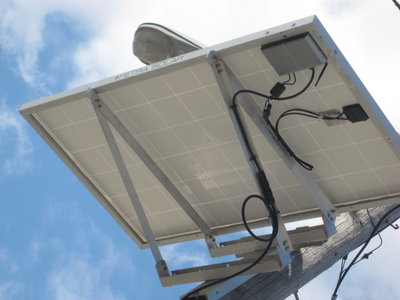You may have seen one in your neighborhood. – large, flat gizmos, angled skyward to catch rays from the sun. The solar panels are part of a gas-and-electric company initiative called Solar4All to install 80 megawatts of solar capacity within their service territory by 2012.
“Enough to power about 12,500 average-size New Jersey homes,” said Public Service Electric & Gas spokesman Fran Sullivan.
The solar panels help PSEG provide energy to homes in an environmentally friendly way, but residents won’t see a cost savings, according to Sullivan.
Don’t expect them to save you any money.
________
Sullivan said that most inquiries they get from the public are not about the cost but about the panels themselves. “They want to know what they are, and when we tell people, they tend to think they’re a pretty good idea,” Sullivan said.
He noted, “State policy mandates a certain amount of renewable energy, and PSEG helps the state make that goal. It was approved under the Corzine administration and now we are 85,000 panels strong.”
3,000 for Jersey City
Some of the panels – like the approximately 3,000 planned for Jersey City – will appear on utility poles. Others will be “in centralized locations, solar farms, rooftop installations — centralized products,” Sullivan said.
There are farms in Edison, Hamilton Township, Linden, Trenton, and five Newark public schools.
An example of a farm is on the Lindin site, where thousands of solar panels are mounted on the ground in front of the town’s generating station at a 30-degree tilt.
“There are even solar systems on warehouses in Bayonne and Perth Amboy,” Sullivan said.
The PSEG territory that will offer solar panels runs from Bergen County, cutting a path through the state to New Brunswick and south of Camden.
PSEG has a contract with Petra Solar, a South Plainfield firm, to supply the panels, which are about 2.5 feet high and 5 feet wide.
Catching the rays
“As long as the panels have clear exposure to the southern sky,” they will do their job of generating power, according to Sullivan.
“All these panels on poles are tied directly into the PSEG electric grid, and they provide solar power to all our customers,” he said.
Some residents have wondered, since the panels are on what laypeople call “light poles,” whether they power street lights.
They don’t, Sullivan explained. There are no batteries for storing power, so it would be impossible for them to provide power at night when the sun is not shining. “They provide solar power right there,” Sullivan said. “When the sun is out and shining, they produce electricity and deliver it to the grid to be used at that time.”
The reason the panels are on utility poles is to take advantage of vertical space which PSEG already owns. The pole-attached units will be installed in about 300 municipalities.
“By utilizing these utility poles, we take up zero land space,” said Al Matos, vice president for renewables and energy solutions for PSEG. “This is a great way to install a large amount of solar capacity in a crowded state like New Jersey.”
Installation started in 2009. In July of that year, PSEG received regulatory approval from the New Jersey Board of Public Utilities to invest $515 million in solar projects.
Solar power augments other forms of power. “It’s meant to be another form of electric generation to go along with things like nuclear, natural gas, coal fire plants, and fossil fuels,” he said.
Why solar?
So, if there are so many other ways of generating power, why solar?
“It’s certainly cleaner,” Sullivan said. “Carbon-free generation emits no pollution, and they’re completely silent.”
PSEG estimates that solar units will reduce the amount of carbon dioxide, nitrous oxide, and sulfur oxide in the air.
The yearly reductions, they say, would be the same as removing about 3,800 cars from the road for one year.
What if I want a solar panel?
Towns that have only gas will not be able to get solar panels. “If a town gets a PSEG electric bill, that town will get solar panels,” Sullivan said.
Will the pole on your block get a panel?
“We know where all the poles are in towns,” Sullivan said. “Crews will go in and survey and install the panels in one sweep, but a pole has to meet three criteria:”
-It has to have an unobstructed southerly exposure.
-It has to have access to the right voltage electric wire. Most households have 120 volts.
-The panel can’t block access to equipment on the pole, such as a capacitor or switch for phone or cable.
Maintenance for solar panels is fairly easy, according to Sullivan. “We monitor them remotely with a radio transponder on the back,” he said, “so we know if one isn’t performing right. Then we go out and fix it or replace it. We don’t have to check on them on a daily basis.”
What if the sun don’t shine?
Many residents wonder what happens with a solar panel if there is no sun.
“It will produce more power on a sunny summer day when the sun is high in the sky and it’s 98 degrees in July than on an overcast day in February,” Sullivan said. “But even a small amount of sun will generate some electricity.”
Kate Rounds can be reached at krounds@hudsonreporter.com..
